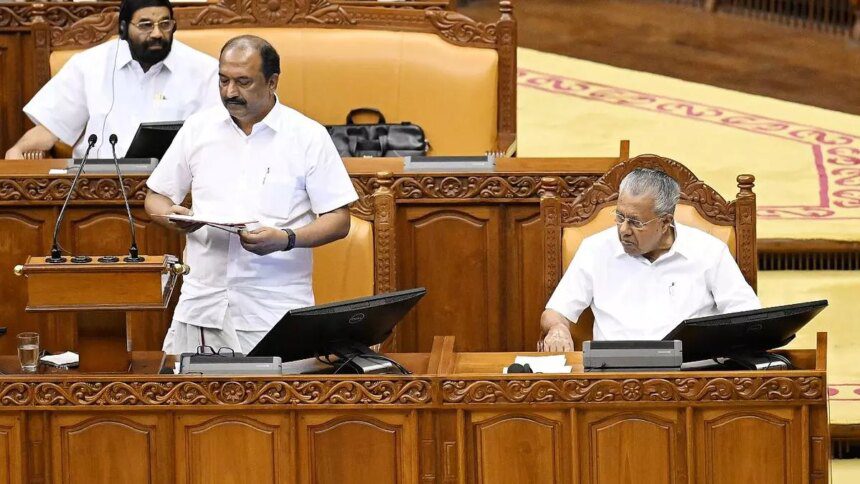Kerala’s Finance Minister, K.N. Balagopal, opted for fiscal prudence over populist measures during the presentation of the 2025-26 State budget on Friday, especially with local body elections approaching and State Assembly elections to follow. In this final budget under Chief Minister Pinarayi Vijayan’s second administration, a cumulative deficit of ₹1,269.46 crore was proposed against an initial balance of ₹234.35 crore.
The budget outlined additional expenditures totaling ₹1,820.50 crore while expecting to raise only ₹366 crore through new tax measures, with concessions nearly negligible at ₹9 crore. Notably absent were anticipated increases in welfare pension payments and the establishment of a wage revision committee for State government employees.
One significant change was the revision of court fees, projected to generate an additional ₹150 crore in revenue. Furthermore, the budget proposed to increase land revenue, with tax rates in existing slabs rising by 50 percent, which would yield ₹100 crore. Additionally, the tax structure for electric vehicles (EVs) is being restructured based on their price. Specifically, EVs priced over ₹15 lakh will incur an 8 percent tax, while those costing more than ₹20 lakh will face a tax of 10 percent. Electric vehicles with battery renting options will also be taxed at 10 percent, regardless of their cost, bringing an estimated ₹30 crore in revenue.
For the fiscal year 2024-25, the state plan outlay is set to increase from ₹30,370 crore to ₹32,500 crore due to significant fiscal challenges imposed by the central government. In a notable shift in policy, the budget aims to convert the Kerala Infrastructure Investment Fund Board (KIIFB) – responsible for financing social infrastructure – into a revenue-generating model. Reports indicate that the State cabinet has agreed to allow tolls on KIIFB-funded road infrastructure.
While part of the working capital is funded by the government’s budget allocation, a significant portion is still raised through interest-bearing loans. The Finance Minister clarified, “In this context, the government will explore options to transition KIIFB into a revenue-generating entity.” He opened his budget speech on a positive note, asserting that the state has successfully navigated through tough fiscal times and declared, “Our fiscal position has improved.” He highlighted investment in human capital as a driving force behind the state’s developmental progress.
Improvements in the state’s own tax revenue (SOTR) and non-tax revenue are indicative of positive changes in fiscal health. From 2021-22 to 2024-25, growth in SOTR reached 15.8 percent, with the combined growth of SOTR and non-tax revenue at 17.4 percent. The revenue deficit reduced from 2.25 percent in 2021-22 to 1.58 percent in 2023-24, while the fiscal deficit decreased from 4.04 percent to 2.9 percent and the debt-to-GSDP ratio improved from 35.92 percent to 34.2 percent.
This reduction in fiscal and revenue deficits has occurred without compromising developmental and welfare spending. There are positive trends in GSDP indicators, suggesting further improvement ahead. Balagopal attributed the increase in revenue expenditure partly to the last installment of pension revision arrears, amounting to ₹600 crore, and noted that two installments of pay revision arrears are now being sanctioned and merged with provident funds. In a move likely aimed at garnering voter support, the lock-in period for two installments of Dearness Allowance arrears has been waived.
Balagopal also highlighted the decline in the state’s share of centrally collected taxes, which has dropped from 3.88 percent during the 10th Finance Commission to 1.92 percent under the 15th Finance Commission. Additionally, the share of grants allocated to local governments has decreased from 4.54 percent in the 12th Finance Commission to 2.68 percent currently. He noted that GST compensation is no longer available, and the fiscal deficit has been kept at a strict three percent of the GSDP. Current loans taken by KIIFB and other obligations, along with deposits in the public account, are now deducted from the borrowing limit. The challenges faced by the state have been presented to the 16th Finance Commission. The budget also includes a ₹750-crore rehabilitation project for the landslide-affected Wayanad region, which the Finance Minister noted did not receive attention in the Union Budget.










